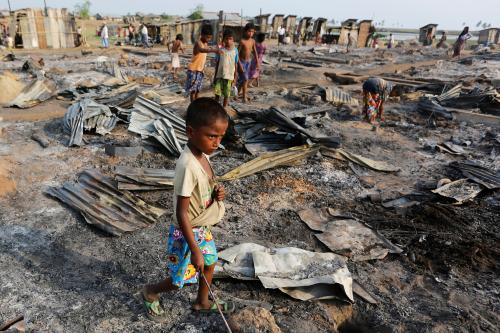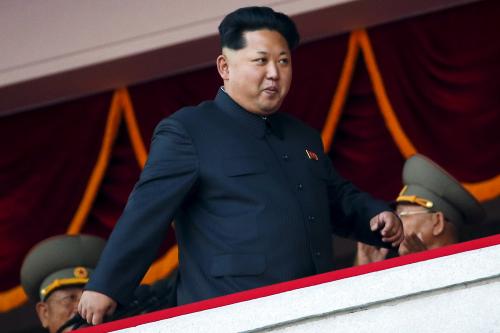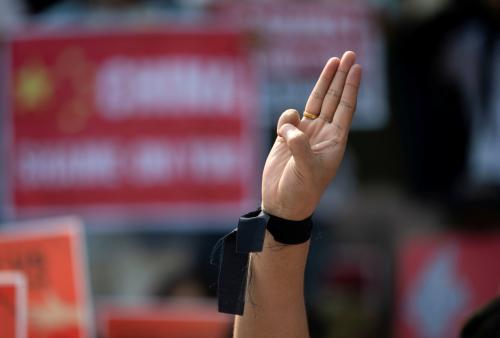In his first address to the United Nations Security Council in January 2017, the new Secretary-General António Guterres stated: “We spend far more time and resources responding to crises rather than preventing them. People are paying too high a price.” He stressed that a “whole new approach” to conflict prevention is necessary.
Indeed, the world is paying a steep price for violent conflict. The United Nations’ 2018 appeal for humanitarian aid funding was record-setting: $22.5 billion to provide aid to 91 million people. Most need is preventable and caused by conflict.
In 2015, the number of conflicts and fatalities spiked and has remained high, to levels unprecedented since the end of the Cold War. Terrorist attacks and their toll have followed a similar trend, peaking in 2014. Externalities are piling up. Forced displacement of civilians is at its highest since the U.N. began keeping track, and recipient and neighboring countries have experienced political destabilization even when the levels of migration have been moderate.
Meanwhile, there has been a revival of proxy warfare and threats of interstate war, in addition to increasing difficulties in resolving large, ongoing wars. The United States, Russia, and China have been at odds in the U.N. Security Council (UNSC), reducing the efficacy of multilateral peace initiatives.
Renewed thinking and focus on conflict prevention is urgent, as it is far more effective and less expensive to prevent conflict than respond to it. How can conflict prevention be applied in Myanmar, Venezuela, and North Korea today?
Does it work?
The primary short- or medium-term tools for preventing imminent war are economic sanctions, preventive diplomacy, and—in very rare cases—preventive deployments of military force. Sanctions, for instance, are credited with contributing to South Africa’s ending of apartheid or Myanmar’s recent democratic opening. Multilateral diplomatic initiatives, such as the U.N.’s Mediation Support Unit, have been effective in preventing conflict. In Macedonia between 1992 and 1999, the United Nations’ preventive deployment of peacekeepers helped that country avoid the wars of its former Yugoslav neighbors.
Long-term prevention measures have also had remarkable impacts, though it can be hard to measure success. For instance, economic development addresses a common root cause of many civil wars. Global reductions in absolute poverty have been dramatic, and the U.N.’s Sustainable Development Goals explicitly link further efforts to conflict prevention. Transnational, systemic conflict prevention has been very successful, including non-proliferation regimes around nuclear, chemical, biological weapons, small arms and light weapons; or efforts to combat conflict diamonds and minerals such as the Kimberley Process or section 1502 of the Dodd-Frank Act.
Successful conflict prevention requires robust international, multilateral commitments. Individual states, guided by self-interest, are unlikely to prioritize conflict prevention. There are few political rewards for success. Good conflict prevention is invisible, because violence does not occur. However, there may be political costs to engaging in talks or imposing sanctions. Multilateral approaches to conflict prevention activities can alter states’ incentives for getting involved in conflict prevention. Further, effective diplomacy, sanctions, or other prevention policies require coordinated, committed action.
2017 has been a year marked by dramatic failures in conflict prevention, including namely the ethnic cleansing of the Rohingya minority in Myanmar; the economic, humanitarian, and political crises in Venezuela; and the degradation of diplomacy in managing North Korea. These failures demonstrate the difficulties of preventing conflict given an international system under stress.
Myanmar
Since August 25, roughly 626,000 Rohingya (of a population of just over a million) have fled from Rakhine state to neighboring Bangladesh; tens of thousands are internally displaced. An unknown number have been killed within Rakhine. First-hand accounts of the violence include descriptions of widespread rape, arson, shelling, and killings. The United States, among many others, has identified this as ethnic cleansing. The U.N. has begun to speak of genocide.
This violence was widely predicted. Governments, civil society, and the United Nations issued repeated warnings over several years. As recently as March 2016, the U.S. Atrocities Prevention Board detailed the vulnerability and targeting of the Rohingyas, describing violations of human rights and several surges of violence. The international community had sufficient advance information on the risks of state-sponsored violence against the Rohingya but failed to organize adequate preventive action. Complicating international response to the violence is the concern over disrupting Myanmar’s democratic transition and the fact that the civilian government, elected in 2015, has no control over the armed forces, while the military remains in a position to reverse reform.
The ethnic cleansing of the Rohingyas is a failure of the international norm of the “Responsibility to Protect” (R2P). R2P establishes the responsibility of states to protect civilians from genocide, ethnic cleansing, war crimes, and crimes against humanity. Mandates under R2P are established with a UNSC resolution, increasingly difficult to pass in a world of resurgent realpolitik. In November, China and Russia prevented the UNSC from passing a resolution condemning the violence against the Rohingya. The UNSC passed a non-binding presidential statement instead.
This is the latest in a series of failures of the norm, including failures to protect civilians in Darfur, Syria, or the Yazidis in Iraq. Equally damaging may be the perception that R2P was invoked in Libya as a Trojan Horse for regime change. November’s UNSC presidential statement on Myanmar may have done less to make its government reconsider its actions against the Rohingya and more to demonstrate that the UNSC would not adopt stronger measures to stop the violence.
Venezuela
Once the richest country in Latin America, Venezuela suffered extreme fragility this year, if not state failure. Potential for civil war or coup is strong. Suffering debt default and hyperinflation, hunger and malnutrition, shortages of medicine, and violent political unrest, Venezuela’s economic crisis has become a humanitarian crisis. Acute child malnutrition rose precipitously. The average Venezuelan lost roughly 20 pounds this year due to food shortages. Infant mortality rose 35 percent; maternal mortality rose 65 percent. Hundreds of thousands of Venezuelans sought refuge in Brazil, Colombia, and Peru, while Panama has closed its borders.
State institutions are in disarray. On March 29, the Supreme Court stripped the powers of the opposition-majority National Assembly. Three months of daily street protests followed, in which over 120 people were killed. President Nicolás Maduro’s response to demands for humanitarian aid and fresh elections was to hold elections for a Constituent Assembly at the end of July. The new body, full of Maduro loyalists, has supplanted the powers of the National Assembly.
Russia has undermined regional governments’ efforts to coordinate a multilateral response aimed at isolating the Maduro regime. The Lima Group, composed of 12 American states, has been organizing multilateral sanctions and making joint statements. The European Union has imposed an arms embargo. However, last month, Russia provided a debt-restructuring package. In November, Russia and China boycotted a UNSC meeting on Venezuela, ruling out Security Council action.
The roots of Venezuela’s crisis were echoed in political violence and instability around the world in 2017. Institutional and electoral manipulation has destabilized several countries this year. Examples include Kenya’s disrupted and delegitimized election and its attendant violence and Liberia’s interrupted elections. Honduras is in the grips of a violent response to what looks like electoral manipulation. Guatemala’s president failed in a bid to dismantle an anti-corruption institution but Congress has since re-affirmed his immunity from prosecution. Spain and Iraq suffered violence and a degradation of democratic governance in the face of secessionist referendums. Doubt has been cast on the impact and quality of electoral observation, the key tool for avoiding electoral violence.
North Korea
While diplomacy, sanctions, and targeted engagement have been successful in preventing conflict on the Korean peninsula for decades, 2017 marks decisive failures in terms of North Korea’s (or the DPRK) nuclear capacities. In September, North Korea tested an “advanced nuclear devise.” The explosive yield of this sixth North Korean nuclear weapons test was larger than the other five test-yields combined. On 29 November, the DPRK conducted a test of its most powerful missile. Experts estimate that the entire United States is, or will soon be, within range of intercontinental ballistic missiles which might carry nuclear weapons.
In parallel, the United States and the DPRK have engaged in bellicose rhetorical brinksmanship, making war between the two states seem increasingly likely. This month, both sides have issued warnings that war is closer than it has ever been since the 1953 armistice. Public acceptance of the possibility of conflict within the United States has ballooned. Mechanisms to head off escalation caused by misunderstandings do not exist. The most effective channel of communication between Washington and Pyongyang may be Dennis Rodman.
North Korea’s demonstration of advanced nuclear capability this year is a failure of the most successful systemic global conflict prevention of the post-WWII world order: disarmament and nuclear non-proliferation. North Korea acquired its nuclear technology through the A. Q. Khan network, and the DPRK now poses a similar risk of further illicit proliferation. Trump has been impatient with multilateral, diplomatic containment of nuclear proliferation. In October, the president declined to re-certify the Joint Comprehensive Plan of Action (JCPOA), the multilateral agreement on Iran’s nuclear program. This repudiation of the Iran agreement limits the credibility of any talks on North Korea that might trade U.S. incentives or sanctions relief for a DPRK freeze on weapons testing or development.
Back to the future?
These three cases highlight the inadequacy and indispensability of conflict prevention. These were lost opportunities for conflict prevention. Myanmar was widely predicted but not prevented. Venezuela and North Korea could be pulled back from the brink of civil or inter-state war, but suffered severely degraded conditions this year. The cases share failures to coordinate among the United States, China, and Russia. In Myanmar, China shielded a protégé regime from intervention. In Venezuela, Russia has undermined multilateral sanctions and blocked UNSC action. North Korea demonstrates the profound damage to international peace that results in the U.S. rejection of multilateralism.
The sharp rise in war and violence is straining states and international organizations, and conflict prevention is more difficult now, perhaps, than it has been since it became a United Nations priority in the early 1990s. Given the requirement of unanimity at the Security Council and discord among the permanent members, the UNSC will likely continue to hinder prevention efforts. New coordinating mechanisms for conflict prevention are necessary.
Despite systemic conditions that make conflict prevention difficult, Secretary-General Guterres is right to prioritize conflict prevention. Increased risks of inter-state war, including nuclear war, overlaid with de-stabilizing civil conflicts in multiple regions, make conflict prevention an increasingly existential imperative. Multilateral efforts to coordinate sanctions, arms embargoes, diplomacy, or implement stronger measures in response to mass atrocities need to be prioritized and incentivized. This is work that the secretary general can pursue within or aside from the Security Council. Ad-hoc organization, such as through the Lima Group, or the group of six countries coordinating diplomacy on North Korea, is a likely avenue forward. Finally, the United States, China, and Russia will need to either cooperate with or ignore effective conflict prevention campaigns. Diplomacy may start and end with these states, but these powers may also bear outsized costs for future failures.
The author would like to thank Charles Call, Brandon Paladino, and Jung Pak for their helpful reviews and comments.









Commentary
The year in failed conflict prevention
December 14, 2017